The Portland Japanese Garden
The Portland Japanese Garden is a popular Portland attraction located on the edge of downtown
Portland in Washington Park. Proclaimed one of the most authentic Japanese gardens outside of Japan, the Garden is a 5.5-acre haven of tranquil beauty nestled in the scenic west hills of Portland, Oregon.
The Japanese Garden is one of my favorite locations in Portland, and I’m sure I am not alone in that opinion. The Garden is peaceful and beautiful and full of gorgeous plants, trees, water features, and other Japanese-inspired scenery. I find that as the Garden changes throughout the seasons in Portland it always offers something worth seeing. Throughout the year, the Japanese Garden hosts special events and rotating exhibits, and its well-curated gift shop is an excellent place to find unique gifts. The Garden offers excellent photo opportunities for amateur and professional photographers, and I personally have used the beautiful Japanese maple trees with their graceful branches and delicate lace-like leaves as a source of inspiration for several oil paintings. In all, the Portland Japanese Garden is an amazing source of inspiration to all who visit, artistic and otherwise.
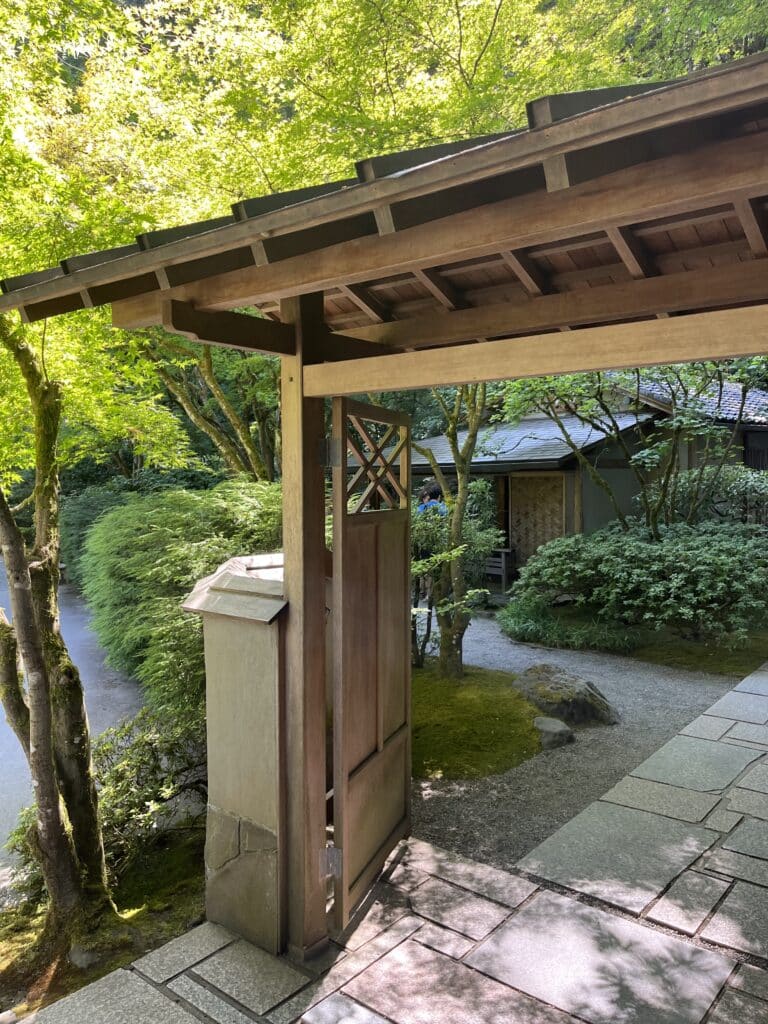
Visiting the Garden
The Portland Japanese Garden is currently open from Wednesday through Monday from 10 a.m. until 4 p.m. and closed only on Tuesdays. The garden recently had to shorten its hours due to labor shortages, but once guests have entered, they are free to roam the grounds until 5 p.m. Admission is $21.95 for adults and $15.95 for children aged 6–17 (with special discounts for seniors and students), which includes access to the Garden, the Garden Gift Shop, the Umami Café, and Art Exhibitions. On my recent Sunday visit, finding a parking spot proved to be a challenge and there was a long line at the entrance, so it would be a good idea to schedule your visit for a weekday if possible to avoid crowds. Nonetheless, it was a beautiful day so I didn’t mind the trek from my car to the Garden and I found I could still enjoy its beauty and serenity along with the many others who were there that day to appreciate those very same qualities.
The Five Gardens at the Portland Japanese Garden
Once you have paid admission, you will enter the Antique Gate and walk up a winding path through the Entry Garden full of towering trees and Northwest native plants. From there you will cross a bridge over the Ecological Stone Creek Bed and arrive in the Tateuchi Courtyard where you can find the Umami Café, gift shop, concierge desk and the Jordan Schnitzer Japanese Arts Learning Center. I recommend taking a detour through the Bonsai Terrace, where you can find an intriguing collection of several species of expertly pruned bonsai trees on display. Walking through the Nezu Gate marks your entry into the Portland Japanese Garden’s five original gardens, each of which is designed to portray an element of Japanese history and culture.
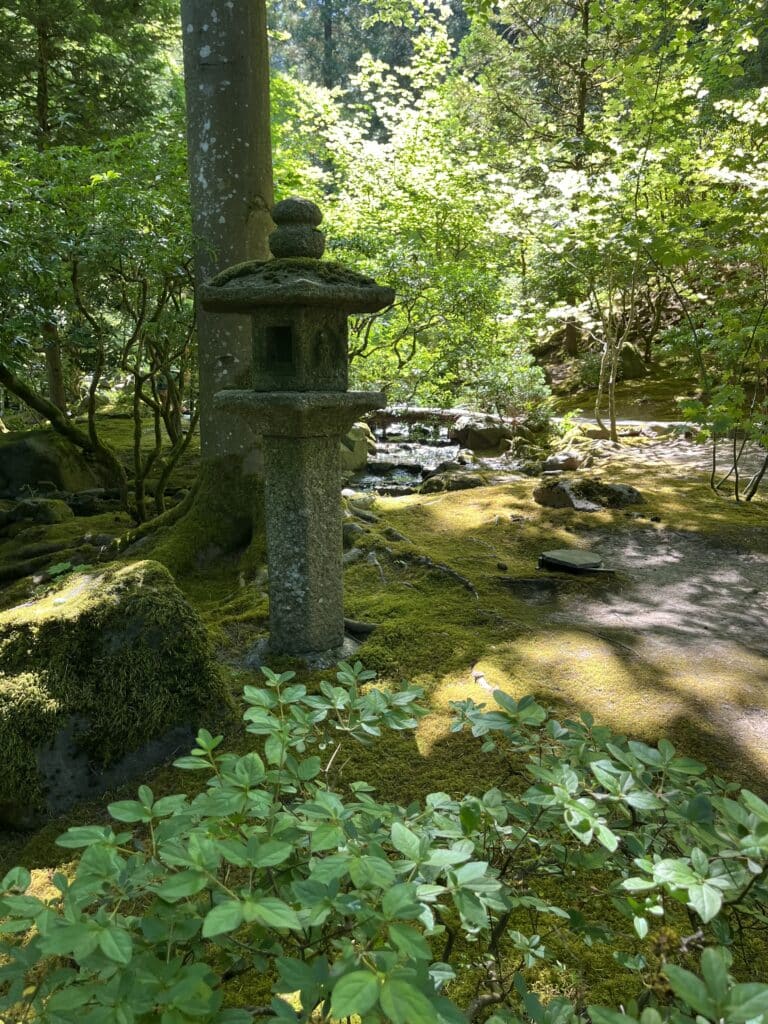
“The 5.5 acre Japanese Garden is composed of five distinct garden styles. When we enter a Japanese garden, the desired effect is to realize a sense of peace, harmony, and tranquility and to experience the feeling of being a part of nature. In a deep sense, the Japanese garden is a living reflection of the long history and traditional culture of Japan. Influenced by Shinto, Buddhist, and Taoist philosophies, there is always “something more” in these compositions of stone, water, and plants than meets the eye.”
(Source: Portland Japanese Garden)
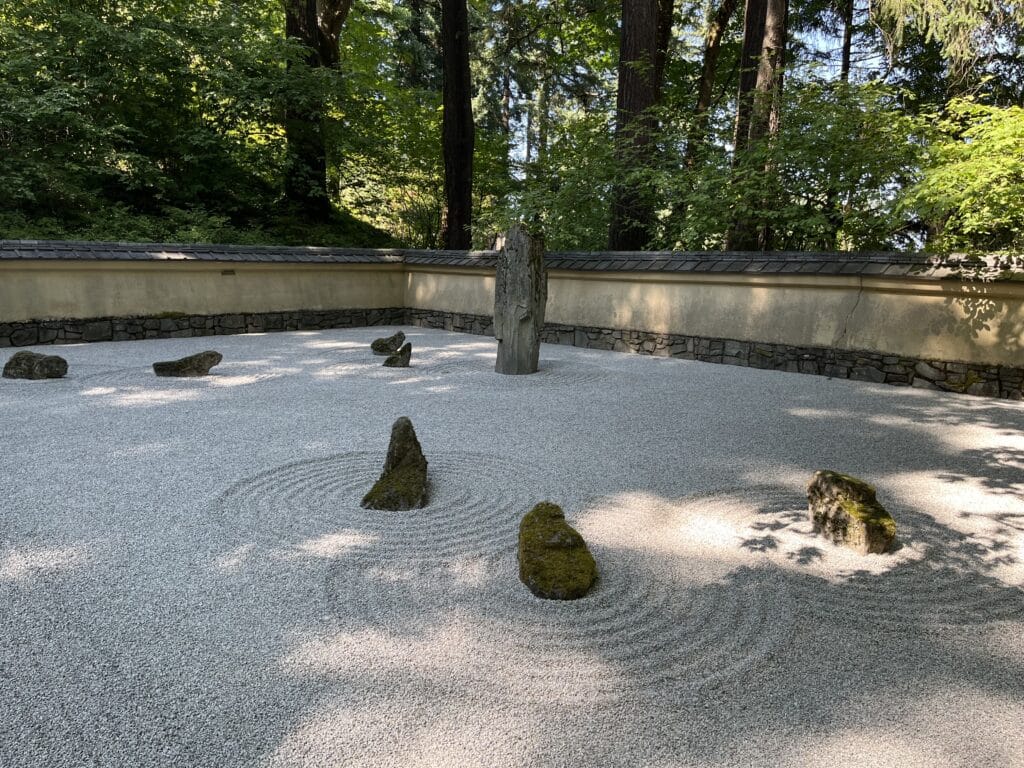
Flat Garden
Located outside the Pavilion Gallery, “the Flat Garden (hira-niwa) is an example of how gardens in Japan have continued to develop the dry landscape style of the karesansui garden over time. In a garden such as this one, the designer worked to balance the relationship between the flat planes (the ground) and the volume of stones and clipped shrubbery and trees to create a sense of depth of space.”
Sand and Stone Garden
Walking down stone steps will lead you to the Sand and Stone Garden, surrounded by three walls and a partial wall at its opening, distinguishing it from the rest of the landscape. “Gardens of raked sand (or gravel) and stone are referred to as karesansui (literally, “dry landscape”) gardens. This style was developed in Japan in the later Kamakura period (1185–1333). Many Chinese landscape paintings of the Southern Sung dynasty were imported to Japan in the 14th and 15th centuries by Zen Buddhist priests, and they were emulated by Japanese artists like Sesshu (1420-1506).”
Natural Garden
Making your way along the path will lead you to the Natural Garden with its thoughtfully placed benches and sitting areas for contemplation. This garden “was created to be an environment that encourages visitors to rest, relax, and reflect on the very essence and brevity of life. This garden in its current configuration is the most recent addition to the Portland Japanese Garden, and it is also the most contemporary style, referred to as zoki no niwa, a style which includes plant materials that fall outside the list of plants traditionally associated with Japanese gardens.”
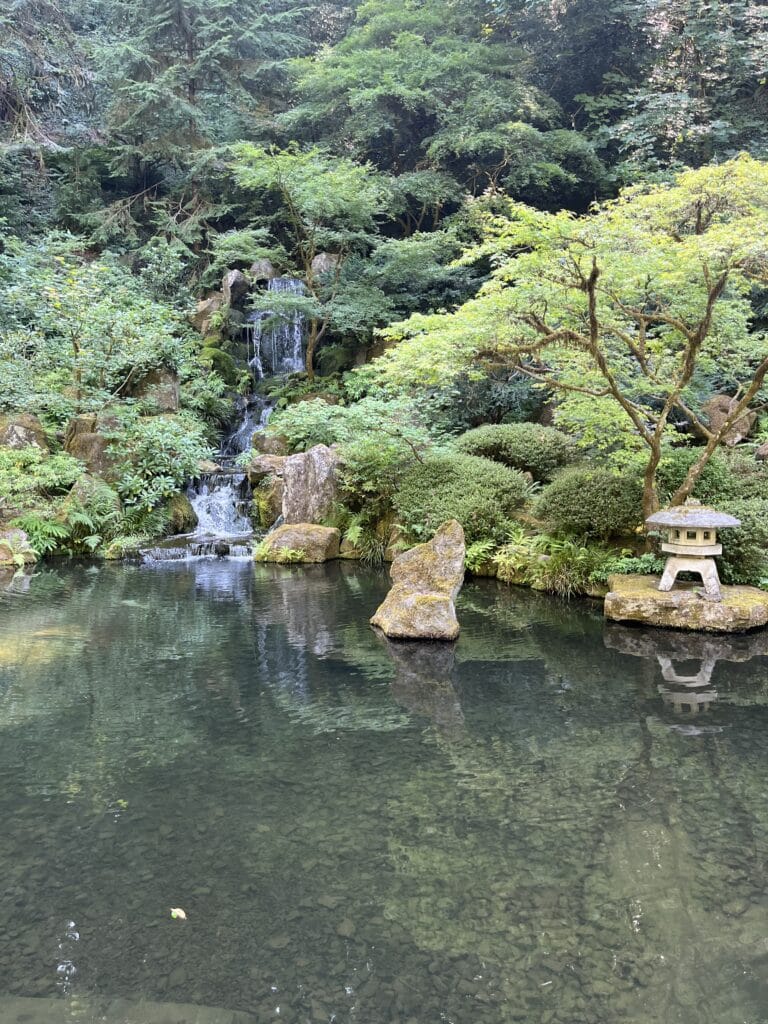
Strolling Pond Garden
The largest of the gardens, “the Strolling Pond Garden [chisen kaiyu shiki teien] consists of Upper and Lower Ponds connected by a flowing stream. The Upper Pond features the iconic Moon Bridge, while the Lower Pond has a Zig-Zag bridge [yatsuhashi] which weaves through beds of Japanese iris against the backdrop of the stunning Heavenly Falls.”
Tea Garden
On the way to the Kashintei Tea House you will walk through the Tea Garden. “A Japanese tea garden [cha-niwa or roji] is a place for quiet reflection on the beauty of nature and the art of living in harmony with one another and with all things. Amid a wooded setting, a pathway with carefully placed stepping stones and lanterns leads through the rustic garden to the teahouse. Tea gardens were historically designed as peaceful, natural spaces to detach oneself from the hectic everyday world before entering the tea house and the tranquil world of tea ceremony [chanoyu].
Noteworthy Attractions and Events
The beautiful glass-walled Umami Café set on a hillside overlooking the grounds is a popular destination within the Portland Japanese Garden. In fact, Garden admission is required in order to visit the Café, and it is recommended to make a reservation ahead of time as the small restaurant quickly reaches maximum capacity. The Umami Café serves traditional Japanese tea alongside light snacks and authentic Japanese confections that you can savor while relaxing in the light-filled space and taking in a panoramic view of the Garden.
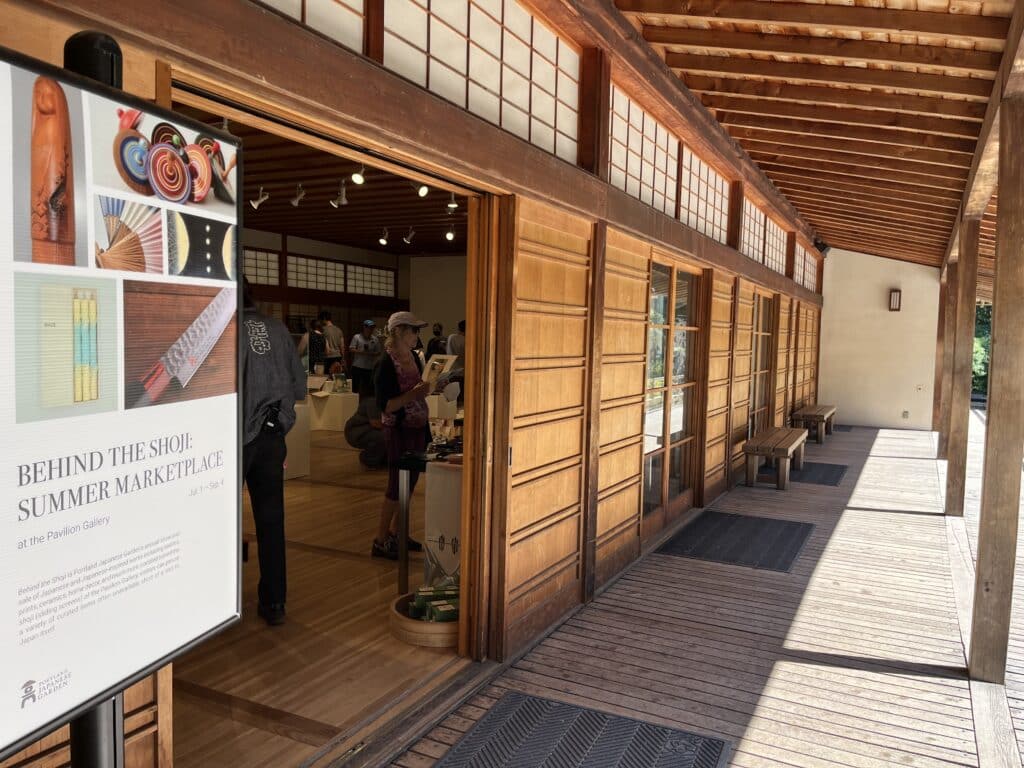
The Portland Japanese Garden regularly hosts Art Exhibitions, which showcase both internationally known and rising young Japanese artists. The exhibitions can be found in the Pavilion Gallery, which also hosts the annual Behind the Shoji Summer Marketplace, and in the Japanese Arts Learning Center.
Blessed with a climate much like that of central Japan, the Portland Japanese Garden enjoys the same dramatic changes of the seasons, celebrating them with a series of five traditional festivals called Go-sekku that have been observed in Japan since at least the 6th century. These Cultural Festivals include Doll’s Day, Children’s Day, the Star Festival, and New Year’s Day – Japan’s most important holiday – which the Garden chooses to celebrate over the traditional Human Day.
Five Festival Celebrations – The cycle of life from birth to death is reflected in the quiet passage of a year in the Garden. Out of the cold, barren days of winter, the first buds appear on the plum and reassure us that spring will come again.
Marking the subtle changes in weather that accompany each passing cycle of the moon, the five festivals were celebrated by farmers who sought the help of the kami, or gods, on these occasions to move the cycle of life forward and bring their crops to harvest successfully.
Garden Mission and Values
The 5.5 acre Japanese Garden is composed of five distinct garden styles. When we enter a Japanese garden, the desired effect is to realize a sense of peace, harmony, and tranquility and to experience the feeling of being a part of nature. In a deep sense, the Japanese garden is a living reflection of the long history and traditional culture of Japan. Influenced by Shinto, Buddhist, and Taoist philosophies, there is always “something more” in these compositions of stone, water, and plants than meets the eye.
The purpose of the Japanese Garden Society of Oregon is to create, maintain, improve, and administer an authentic, world-class Japanese garden in the city of Portland and to offer compatible educational, cultural, artistic, horticultural, environmental, and charitable activities.
Core Values: We believe in and strive for: Inspiration, serenity, tranquility, and the aestheticism of nature. Excellence in the management and maintenance of the garden. Japanese culture, tradition, and aesthetics. Cultural authenticity directed to the needs of diverse local, national, and international communities. Environmental awareness and conservation, and the pursuit of environmental sustainability in the operation of the Garden. Mutual respect and harmony within the board, staff, membership, and with surrounding communities.
Volunteer at the Garden – The Japanese Garden Society of Oregon was founded as a nonprofit organization in 1962 and is maintained through admissions, memberships, special gifts, and donations. The Society currently has over 4,500 members and relies on the dedication of the many volunteers who generously give their time to help with Garden events and activities.
Portland Japanese Garden Map and Directions
The Portland Japanese Garden is worth a visit for the opportunity to personally experience its beauty and tranquility and the culture it celebrates – though I would recommend several visits to truly appreciate all that the Garden has to offer. Along with the Garden’s seasonal transformations, the ever-changing art exhibits, tea and cultural demonstrations and festivals continue to offer its visitors something new to learn and enjoy.


